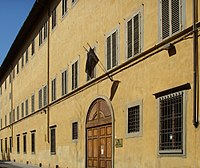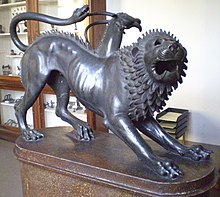National Archaeological Museum of Florence
| Data | |
|---|---|
| place | Florence , Italy |
| Art |
Archaeological Museum
|
| architect | Giulio Parigi |
| opening | 1855/1870/1880 |
| management |
Maria Cristina Guidotti (Egyptian Collection)
|
| Website | |
The National Archaeological Museum of Florence (Italian: Museo archeologico nazionale di Firenze) is an archaeological museum in Florence , Italy. It is located in the Palazzo della Crocetta , which was built by Giulio Parigi in 1620 for Princess Maria Maddalena de 'Medici , the daughter of Ferdinando I de' Medici .
history
The museum was inaugurated in the presence of King Victor Emmanuel II in 1870 in the buildings of the Cenacolo di Fuligno on Via Faenza. At that time it only exhibited Etruscan and Roman finds. As the collection grew, new premises became necessary, and so the museum moved to the current building in 1880.
The first foundations of the collection were laid by the family collections of the Medici and Lorraine, along with some transfers from the Uffizi until 1890 (with the exception of the collection of marble sculptures that the Uffizi already owned). The Egyptian section was founded in the first half of the 18th century from parts of the collection of the Habsburg Grand Duke of Tuscany Leopold II . More parts were added after an expedition from 1828-29 led by Ippolito Rosellini and Jean-François Champollion . In 1887 a new topographic museum was added to the Etruscans, but it was destroyed in the 1966 flood .
Etruscan collection
The organization of the Etruscan spaces was rethought and reorganized in 2006. Also in 2006, the 40-year restoration of over 2000 objects damaged in the 1966 flood was completed.
- The Mater Matuta funeral statue (mid-5th century BC)
- The Arezzo Chimera (late 5th or early 4th century BC)
- The sarcophagus of the Amazons (4th century BC)
- The bronze mirror of Tuscania (4th century BC)
- The bronze mirror of Volterra (4th century BC)
- The sarcophagus of Larthia Seianti (2nd century BC)
- The bronze statue of Arringatore (1st century BC)
Roman collection
- The Idolino Pesaro , a 146 cm high bronze statue of a young man, a Roman copy of a classical Greek original, found in fragments in the center of Pesaro in October 1530.
- The Torso di Livorno , copy of a Greek original from the 5th century BC. Chr.
- Statue of a young rooster, called the Gallo Treboniano , a work of the late 3rd century.
- The Minerva des Arezzo , a bronze Roman copy of a Greek model from the 4th century BC. BC, dedicated to the Praxiteles.
Greek collection
The rich collection of ancient Greek ceramics is shown in a large room on the second floor. The vases mostly come from Etruscan tombs. They prove the close cultural and economic exchange of the Etruscans with Greece, especially with Athens , where most of the vessels were made. A black-figure crater , which is signed by both the potter Ergotimos and the painter Kleitias , is well known. It is called Françoisvase after the archaeologist Alessandro François, who found it in an Etruscan tomb in 1855.
Egyptian Museum
The Egyptian Collection is known as the Egyptian Museum . It is the second largest collection of Egyptian artifacts in Italy after the Museo Egizio in Turin .
founding
The first collection of Egyptian antiquities in Florence was the Medici collection, dated to the 18th century. In the nineteenth century, Leopold II began acquiring artifacts that are now housed in the Egyptian Museum. Together with Charles X (France) he financed a scientific expedition to Egypt from 1828 to 1829. The expedition was led by Jean-François Champollion , who in 1822 deciphered the hieroglyphs . Ippolito Rosellini , a friend and student of Champollion, represented Italian interests on this expedition. He thus became the father of Italian Egyptology . Many artifacts were collected during this expedition, both through archaeological digs and through purchase from local traders. On the return trip they were evenly divided between the Louvre in Paris and the new Egyptian Museum in Florence.
development
The museum was officially opened in 1855 . The first director was the Piemontese Ernesto Schiaparelli . He later became director of the larger Egyptian Museum in Turin . By 1880 he had cataloged the collection and organized the transport of the antiques to the Florentine Archaeological Museum. Under Schiaparelli, the collection was expanded to include further excavations and purchases from Egypt. However, many of those artifacts were later given to Turin .
The Florentine collection continued to grow in the period after him, as contributions from private individuals and scientific institutions were made. In particular, the Florence Papyrological Institute supplied artifacts from its expedition to Egypt in 1934 and 1939. These now form one of the most fundamental collections of Coptic art and documents in the world.
The Egyptian Museum today
The museum now has a permanent staff including two professional Egyptologists. It houses more than 14,000 artifacts spread across nine galleries and two depots. The artifacts on display have been thoroughly restored. The old classification system of Schiaparelli was replaced by a new, chronological and partly topographical system.
The collection offers material that ranges from the prehistoric era to the Coptic Age. There is a remarkable collection of steles , mummies , ushabti , amulets and bronze statuettes from different ages. There are statues from the reign of Amenhotep III. , a chariot from the early eighteenth dynasty, a pillar from the tomb of Seti I , papyri of the New Testament ( 2 , 65 ) and many other artifacts from various periods of time.
photos
Mummy portrait from Al Fayyum
Ptolemaic stele
See also
Web links
- Official website (Italian)
Individual evidence
- ^ Max Planck Institute in Florence - information on the 1966 flood at the Kunsthistorisches Institut in Florenz
- ^ W. Decker: Wagen, in: W. Helck; W. Westendorf: Lexicon of Egyptology, Volume VI, Wiesbaden 1986, Sp. 1131.







